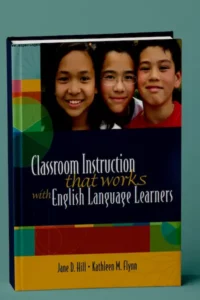Classroom Instruction That Works with English Language Learners and applies them to students in the process of acquiring English.
Classroom Instruction That Works with English Language Learners
Language is the air that we breathe and the water in which we swim. It comes as naturally to us as seeing the sky or digesting our food. It is as vital a part of us as our name and personality. But what if we suddenly had to breathe different air or swim in different waters? What if we consciously had to think about selecting the words we were going to say, getting them in the right order, applying the correct grammatical rules, and using the correct pronunciation? If we had to think about not only what we say but also how to say it, the language overload would be exhausting.
Think about a time when you traveled to a place where English was not the dominant language. Remember how you felt when you returned home and heard English for the first time since you had left? What did you feel? Relief? Safety? Comfort? Friendship? We are our language.
In addition, language has always been the medium of instruction: As teachers, our automatic use of English helps us to create or produce something new for students. We can create stories, produce explanations, construct meaning when we read, and help students make meaningful connections—all by just opening our mouths. Although we may have to deliberately concentrate on classroom management or what activity we will do next, we are not thinking about the order of words in our next sentence.
With the influx of English language learners (ELLs) in mainstream classrooms today, however, the comfortable, automatic sense of “just talking” is being shaken up. What we previously did not have to think about, we now have to think about very carefully. We suddenly find ourselves having to accommodate the one thing we take for granted: language. We are experienced accommodators when it comes to rates of learning, behaviors, and modes of response. We can accommodate anything, from students with special education needs to those with hygienic needs, but up until recently we have not had to make accommodations for language.
Aside from accommodating for students with violent tendencies, accommodating for language is one of the most difficult tasks we face as mainstream teachers. To teach students a new language is to help them know its sounds (phonology), its words (lexicon), and its sentence formation (syntax and semantics). To help students learn content in a new language, we must use clear and concise articulation, make eye contact, use visuals, employ gestures/body movement/ pantomime, use shorter and simpler sentences at a slower rate, use high-frequency vocabulary, and eliminate idiomatic expressions. We also have to model, scaffold, access, and activate students’ prior knowledge; provide cooperative learning activities; and differentiate instruction. Making such accommodations helps provide better instruction for all of your students.
Classroom Instruction That Works with English Language Learners
Classroom Instruction That Works with English Language Learners: As more and more English language learners (ELLs) are included in mainstream classrooms, what can we do to ensure that they understand academic content and develop their English language skills?
To answer this question, authors Jane Hill and Kathleen Flynn have examined decades of research, interviewed mainstream teachers with ELLs in their classrooms, and reviewed the classroom recommendations from Marzano, Pickering, and Pollocks seminal Classroom Instruction That Works (2001) through an ELL lens. The result is Classroom Instruction That Works with English Language Learners—a comprehensive guide to helping elementary school students at all levels of English language acquisition succeed.
The strategies discussed in the book include homework and practice, summarization and note taking, and use of nonlinguistic representations, among many others. For each strategy, the authors provide a summary of the research, detailed examples of how to modify the strategy for use with ELLs in mainstream classrooms, and teacher accounts of implementation. Because ELLs face cultural hurdles as well as linguistic ones, this book also shows teachers how to glean insight into students’ backgrounds and address the cultural biases inherent in many classroom practices.
Accommodating English language learners is one of the greatest challenges educators face today. Just as different levels of fluency require different approaches, so too do different backgrounds and languages. This practical, research-based book gives elementary school teachers the guidance they need to help ELLs of all nationalities thrive alongside their English-dominant peers.


